A sand tiger shark is a unique type of shark that is not related to a tiger shark in any manner. Some of the other names given to the sand tiger shark are spotted ragged-tooth shark, grey nurse shark, and even blue-nurse sand tiger. The scientific name for the sand tiger shark is Carcharias taurus, and it is found not only in oceans but within aquariums as well. You might have seen one while on a field trip to your local aquarium. We’ve gathered a few of the more interesting points about these sharks, so let’s dive right in.

Here are 10 incredible sand tiger shark facts!
1. They are not related to tiger sharks.
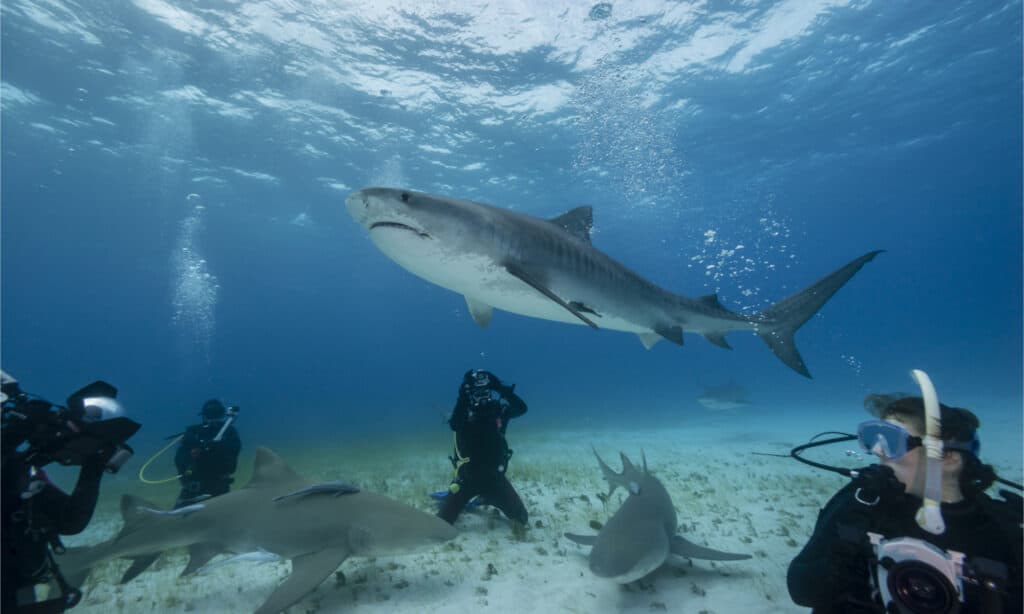
Despite the name, sand tiger sharks are not related to tiger sharks.
©wildestanimal/Shutterstock.com
Yes, that is the first thing we told you, but let’s get the facts straight. Both species are neither related nor do they look alike. On top of that, they belong to two different orders. However, the sand tiger sharks do come from the same order as the great white shark.
A tiger shark has a pattern of spots and stripes all over its body, which resemble the body of a tiger. Hence, the name, tiger shark. In contrast, sand tiger sharks have reddish spots on their backs and are found in sandy areas. Combining both these features, their name becomes clearer in reasoning.
2. They are the most common sharks found in an aquarium.
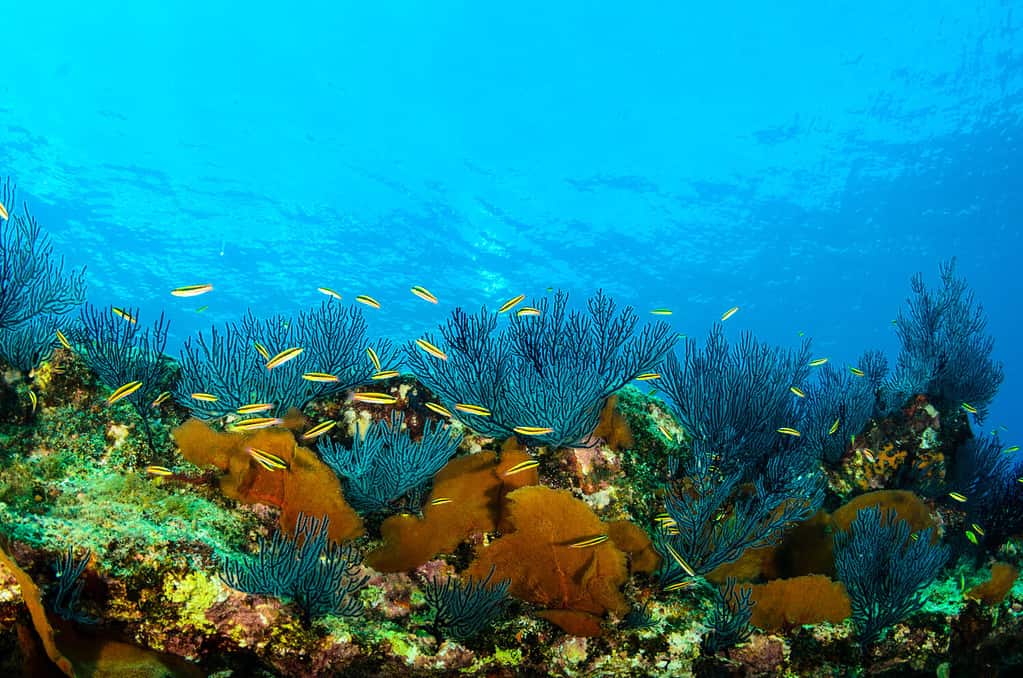
Sand tiger sharks tend to do well in aquariums.
©Leonardo Gonzalez/Shutterstock.com
If you have ever been to a public aquarium, there is a high chance that it contains one of these ferocious beasts. The reason for their popularity in aquariums is that they are better grown than other sharks in captivity.
They are known to live over 16 years in an aquarium, making them a popular hit in various marine parks. The ten feet tall shark has been seen gobbling its tank mates. On top of that, they form hunched backs due to the captive environment.
3. They have a very small litter size.

Sand Tiger Shark mothers only have a few eggs hatch per cycle.
©iStock.com/mirror-images
Unlike many sharks, they produce only 2 to 3 pups in one reproduction cycle. They have several eggs inside them, but only 2-3 actual eggs hatch.
Moreover, their females breed after a couple of years, causing further distress in their population size. Statistics show that only 400 sharks are currently breeding near the coasts.
Their mating behavior is similar to other sharks, involving a ritual of biting each other. But the one dominating characteristic about their babies is that they are capable of hunting and fighting off any would-be predators immediately after birth.
4. They store air above water.
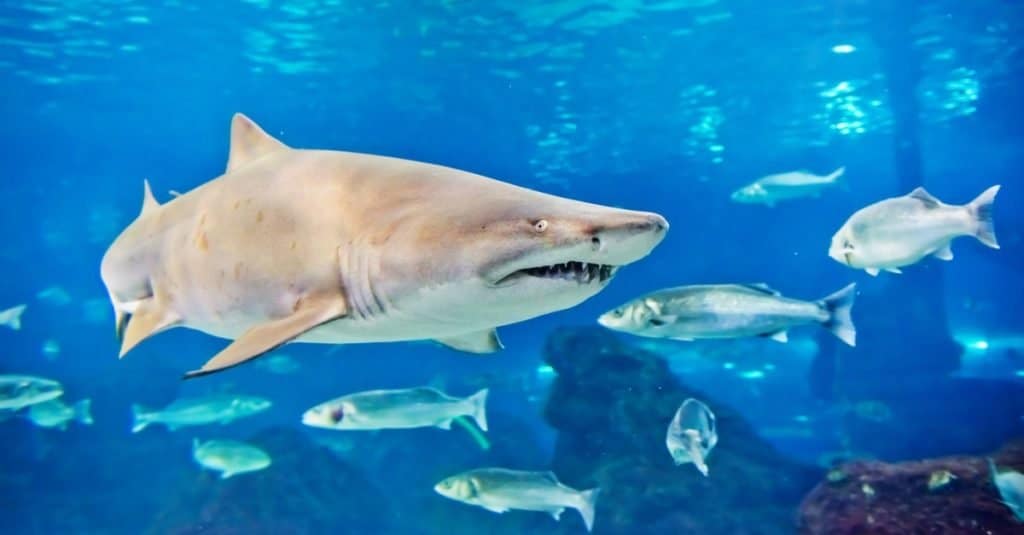
Sand tiger sharks take in air from the surface and use it for buoyancy.
©Valeri Potapova/Shutterstock.com
An interesting thing you will find about these sharks is that they come out of the ocean to store air.
This air goes into their stomachs and as a result, they float along motionlessly into the depths of the ocean. This characteristic is not for breathing but mainly because it helps them maintain buoyancy in the water. It also helps them in silently stalking and hunting down their prey. It is quite creepy if you think about it.
They can easily let out this stored air to return to a normal state. Usually, a stream of air bubbles is released, indicating that they are ready to make the dive. This gulping and burping mechanism is only found in this type of shark.
5. Embryos fight for survival.
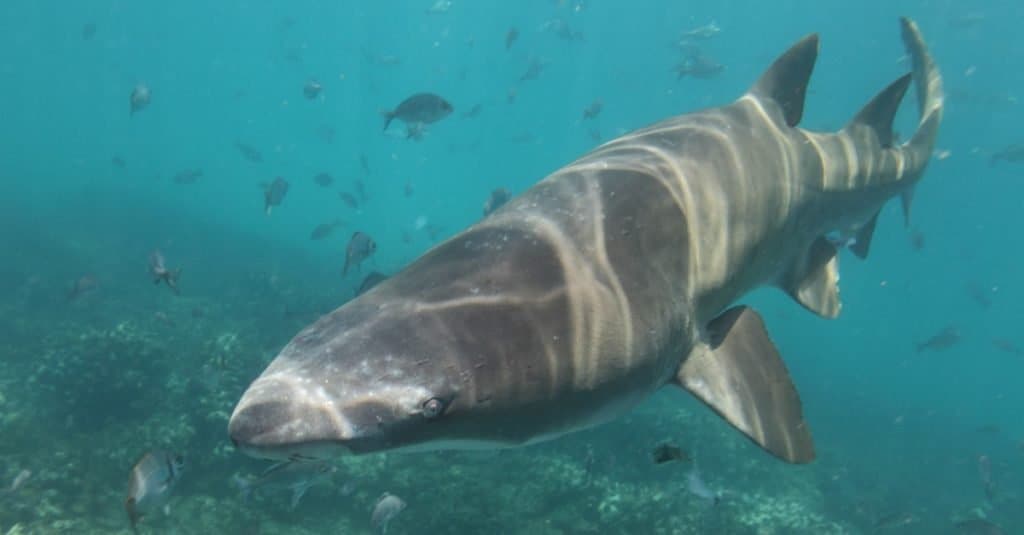
The largest hatched sand tiger shark baby typically eats the other, smaller embryos.
©Alessandro De Maddalena/Shutterstock.com
As you already know now that the shark babies of the Sand Tiger Shark become independent immediately after birth. This has an interesting backstory.
Through biting and circling, the male Sand Tiger Sharks dispose of sperm from their fins into the female’s body. They have a pair of uteri that holds 5 to 50 eggs but all of them do not survive the battle within.
The gestation period of the Sand Tiger Shark is usually around 5 months. During this time, the eggs turn into embryos and then hatch into babies. But what happens is that the largest and the fiercest of the bunch eats up the unhatched eggs, the smaller babies, and the weakest embryos.
All in all, it remains the only one surviving and comes out as an independent predator. That is why only two to three babies are born, one or rarely two from each uterus.
6. They look quite dangerous.
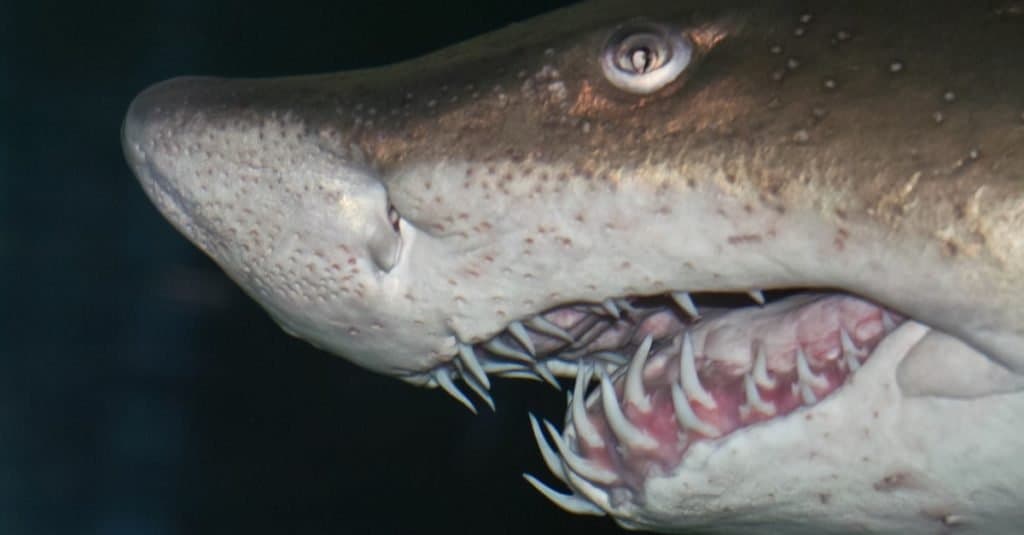
With visibly sharp teeth and unblinking eyes, sand tiger sharks look the part of a dangerous shark.
©MP cz/Shutterstock.com
One common thought about sharks is that they are dangerous but the Sand Tiger Shark looks dangerous as well.
As we have established, they stalk their prey silently. But when you look at them closely, it makes their hunting behavior much more fierce. They have three sets of pointed, small teeth that are visible most times even when their mouths are closed.
Moreover, they do not blink because they do not have any eyelids. Yes, you can spot them rolling their eyes a lot. And not on a snide or sarcastic note but for protecting their eyes against dust. Plus, they are huge, around 10 feet in length.
7. They hunt in groups.

Sand tiger sharks use group tactics for hunting.
©Tomas Kotouc/Shutterstock.com
Like most sharks, the Sand Tiger Sharks hunt together in groups. Often, they are found in clusters launching themselves after prey to gobble them up whole. Imagine the fiercest-looking sharks after you. And not just one, but a whole group of them creeping up motionlessly. Yes, it is a scary sight for sure.
8. … But they do not harm humans.
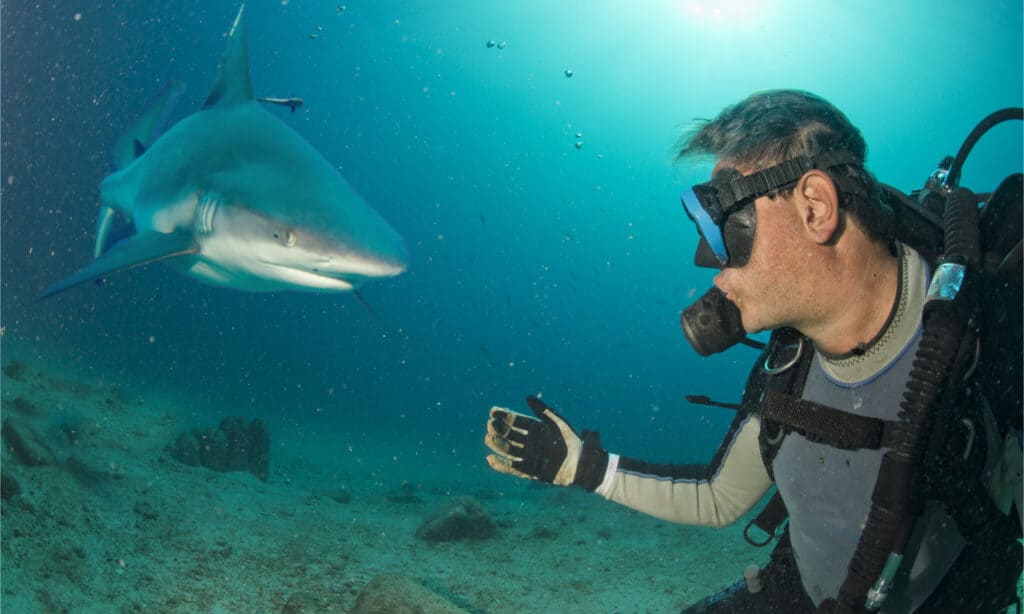
Sharks are not usually aggressive towards divers unless provoked.
©Andrea Izzotti/Shutterstock.com
They are not known to hurt humans unless provoked. The only attacks that have been reported by a Sand Tiger Shark are around 50, none of which were fatal. This number has remained the same for a number for centuries now. Although they like to keep their distance from humans, they are known to steal away fish from spear and net fishers.
9. They prefer to travel long distances.

You can find sand tiger sharks in many places on Earth.
©studio23/Shutterstock.com
The Sand Tiger Shark is found almost all over the world. This is because they like to travel around in search of warm waters. They can be found in all the major oceans of the world, from America to Japan and even Australia. But they can be seen exploring shallow bays, reefs, and sandy coastal areas giving it the name of the Sand Tiger Shark.
The mating and the gestation period are done in the warmer waters but the birth is given in the colder parts of the ocean.
10. Lampreys can kill them.
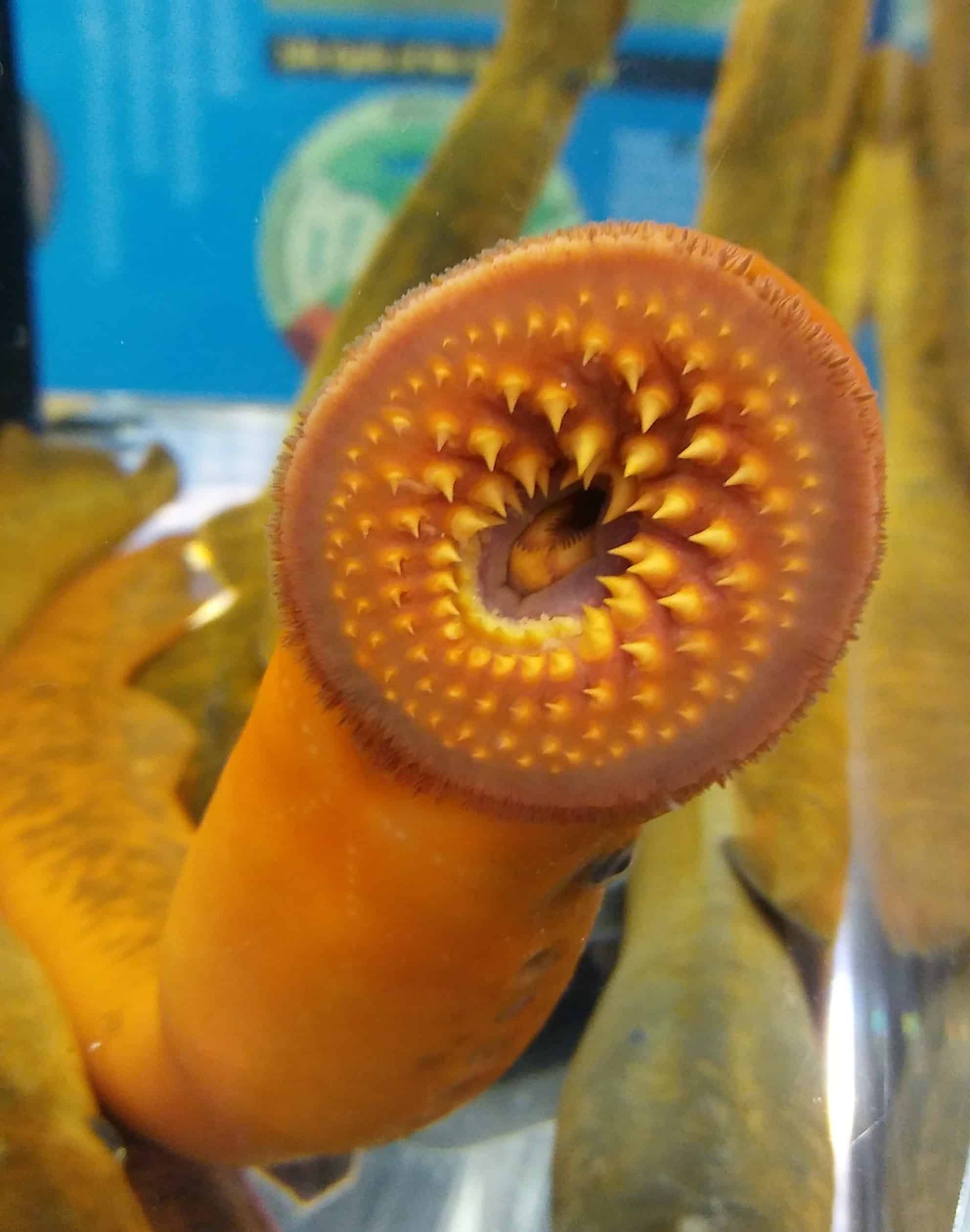
The lamprey’s attack can be a slow death even for a big hunter like a sand tiger shark.
©Theresa Grace/Shutterstock.com
Sand Tiger Sharks are quite dangerous when they are hungry. Some of their prey include lobsters, squid, some small fishes, and even certain sharks.
But even with its ferocious way of life, it does have a few predators of its own like the Bull Shark, the Great White Shark, and the Tiger Shark to name a few. But one predator that may shock you is a lamprey. It sucks out the blood of the Sand Tiger Shark and kills it slowly.
The photo featured at the top of this post is © iStock.com/mirror-images
Sources
- Shark Sider, Available here: https://www.sharksider.com/sand-tiger-sharks/
- National Geographic, Available here: https://www.nationalgeographic.com/animals/fish/facts/sand-tiger-shark
- Animals Time, Available here: https://animalstime.com/sand-tiger-shark-facts-amazing-grey-nurse-shark-facts/
- Mental Floss, Available here: https://www.mentalfloss.com/article/554850/11-facts-about-sand-tiger-shark
- IP Factly, Available here: http://ipfactly.com/sand-tiger-sharks/
FAQs (Frequently Asked Questions)
Do sand tiger sharks attack humans?
Sand tiger sharks, also known as gray nurse sharks, have a deceivingly ferocious look. They are large-bodied and display a mouthful of sharp teeth that protrude in all directions, even when the mouth is shut. Despite this, they are a docile, non-aggressive species, known to attack humans only when bothered first.
What is the difference between a tiger shark and a sand tiger shark?
The blue-nurse sand tiger shark is unusual in that its dorsal and anal fins are the same size. The tiger shark has one large and one small dorsal fin. The sand tiger is brownish grey on top while the tiger shark is blue or even pale green with tiger stripes that fade as the animal gets older.
Is the sand tiger shark going extinct?
Conservation status of the sand tiger shark varies based on the geographic region. Globally they are listed as vulnerable, while in the areas of the western Mediterranean, Europe, and eastern Australian coast they are rated as critically endangered due to commercial fishing.
Thank you for reading! Have some feedback for us? Contact the AZ Animals editorial team.






